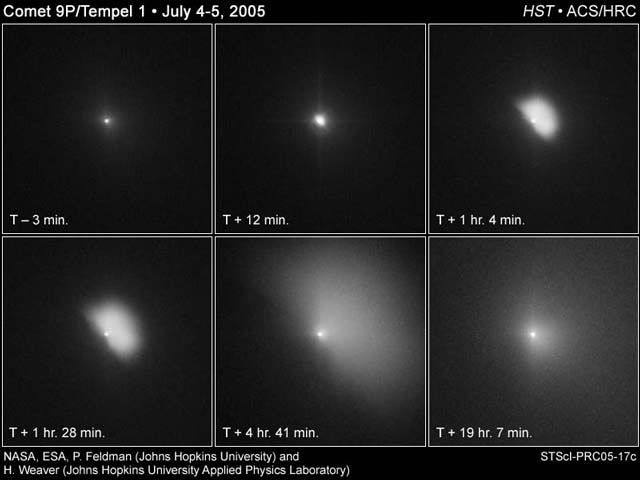Explanation: It was a human-made event visible across the Solar System. At the direction of terrestrial scientists, a refrigerator-sized probe from the Deep Impact mission struck Comet Tempel 1 on July 4 at over 35,000 kilometers per hour. The unexpectedly bright explosion was not nuclear but rather originated from a large plume that reflected back sunlight. Pictured above is how the event looked to the Earth-orbiting Hubble Space Telescope. A large cloud of bright material is seen emanating from the comet's nucleus and then dispersing. The area encompassing the comet became over three times brighter in the hours after the impact. Astronomers will continue to study the images and data returned by Deep Impact to better determine the nature of Comet Tempel 1 and discern clues about the formation dynamics of the early Solar System.
Norwegian APOD mirror now available
1999 2000 2001 2002 2003 2004 2005 2006 2007 2008 2009 2010 2011 2012 2013 2014 2015 2016 2017 2018 2019 2020 2021 2022 2023 2024 2025 |
Yanvar' Fevral' Mart Aprel' Mai Iyun' Iyul' Avgust Sentyabr' Oktyabr' Noyabr' Dekabr' |
NASA Web Site Statements, Warnings, and Disclaimers
NASA Official: Jay Norris. Specific rights apply.
A service of: LHEA at NASA / GSFC
& Michigan Tech. U.
|
Publikacii s klyuchevymi slovami:
Deep Impact - HST - komety - kosmicheskii teleskop im.Habbla
Publikacii so slovami: Deep Impact - HST - komety - kosmicheskii teleskop im.Habbla | |
Sm. takzhe:
Vse publikacii na tu zhe temu >> | |
